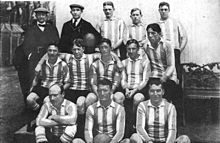British sailors would take footballs with them to relieve the boredom on board ship and to play football near their docked vessel. They would of course bring back goodies from far and wide (beef?).
In South America, ships on the great trade triangle would entertain themselves in a variety of ways, one of those by playing a game of football on a flattish beach or quayside.
In the 1860-70s foreign capital and immigrants poured into Argentina particularly around the River Plate estuary, playing an important part in developing agriculture and railways. Two young Yorkshiremen from Skelton, formed a football team to relieve the commitment to the city's commerce and banking in Buenos Aires.
On June 20th 1867, James and Thomas Hogg, with close friend Walter Heald, organised the first official match played on the continent. The wool trade brought the Yorkshire lads to the country, once it had won its independence from Spain. Father Thomas, owned a textile mill in Yorkshire and having set up a business in Argentina, he became an important expatriate in Buenos Aires, helping set up a commercial centre and British Library, along with a cricket club which left the locals bewildered.

Son, Thomas, above, formed the Dreadnought swimming club in 1863 and brother James organised the Buenos Aires Athletic Society in 1867. They both set up the first rugby match that took place at the cricket club in 1974. Needless to say a golf course followed-the first in Latin America and then tennis got an airing.
Thomas was giving a copy of the newly formed FA Laws (1963) in 1867 and soon the game was evolved along side rugby. The founding committee included the "Skelton" brothers, Thomas Jackson from Cumberland, Thomas Barlow Smith from Stoney Middleton (Derbyshire) and Walter Heald from Pendle, a good northern spread.
The first pitch used happened to be a field planted in alfalfa but they had to carry their goalposts from place to place using a vacant field and made sure that the local English newspapers got wind of their initiative. One such field happened to be in the residential area, La Boca; you know the rest.
On June 20th 1867 the first authentic football match took place on Argentina's National Flag Day and bank holiday at the Buenos Aires Cricket Club in Palermo suburb. As history reveals, only English football and the formation of the Sheffield FC pre-dates this event and the date is closely matched by the founding of Queen's Park in Glasgow.
 International football did not get going until the start of the 20th Century although the Scottish tea magnet, Sir Thomas Lipton, presented a trophy to be played for between Argentina and Uruguay
International football did not get going until the start of the 20th Century although the Scottish tea magnet, Sir Thomas Lipton, presented a trophy to be played for between Argentina and UruguayThe participants had to review the wearing of shorts in front of "ladies" but soon played an 8 a side game involving all Brits except for William Boschetti who had been born in St Lucia.
The Rojos (reds) wore red caps of course and the Blancos white. Score 4-0 to Rojos made up from two Hogg brothers and friends. The game developed slowly for a while but circumstances, such as an economic crash, the "social" popularity of rugby caused by the variation in "rules" introduced from England, the spread of yellow fever (killed over 26,000) , civil war and more unrest prevented a rapid development of the game. The rich of course preferred less "working class" activities.
 v Uruguay 1908 La Albiceleste (the sky blue and whites)
v Uruguay 1908 La Albiceleste (the sky blue and whites)
No comments:
Post a Comment